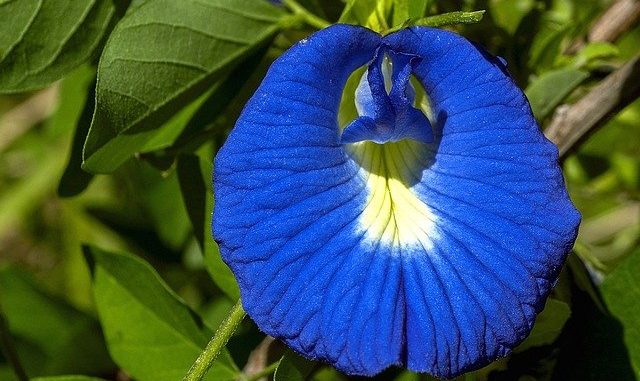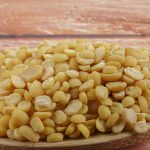
Butterfly pea (Clitoria ternatea) is a marvellous example of a natural blue produced by various anthocyanins. The petals have a striking vibrant blue colour. The plant is used as a medicinal in local herbal culture.
A related blue comes from Ipomea or the Morning Glory which also has a striking royal blue colour but has not been used for food.
The species is one a number in the genus which are found in the tropical regions from Australia to the Americas. It is not an easy plant to cultivate but is very popular as a greenhouse climber in cold temperate countries. All are members of the Fabaceae. C. ternatea grows widely throughout Malaysia and the Moluccan Straits.
Different forms have white and mauve flowers versions as well. The plant bears solitary, axillary papillionaceous bright blue petals flowers with white or light yellow at the centre.
The anthocyanins and phenolics in the petals are potential candidates as medicinal drugs.
Food Use
Flower extracts are used to dye rice cakes in Malaysia. The flowers are eaten as vegetables in Kerala (India) and in the Philippines.
A recent study explored the anthocyanins for their stability towards pH. These anthocyanins have a certain thermal stability when the pH was 3.6 and 5.4 which might make them suitable for applications in beverages and acidic dairy products. the addition of fructooligosaccharides also helped stabilize these pigments (Escher et al., 2020).
Anthocyanins In Butterfly Pea
The type of anthocyanins which generate such striking blue colours are from delphinidins which are usually heavily acylated. These are often described as ternatins and there are over 15 of these known. Terahara et al., (1990) isolated six of these using reverse-phase HPLC.
Later studies isolated nine ternatin anthocyanins and three glycosylated quercetins using high-performance liquid chromatography diode array detection and electrospray ionization/mass spectrometry (HPLC-DAD-ESI/MSn) (Nair et al., 2015).
The anthocyanins also have product development potential as colour changing pigments in ‘magic’ formulations. Changes in pH produce colour variations which might lend novelty to food formulations. These colour shifts might also prove useful in pharmaceutical films that rely on pH changes for drug release. An easily viewed visible colour change may prove valuable in monitoring release from encapsulated materials (Wutticharoenmongkol et al., 2021).
References
Escher, G. B., Wen, M., Zhang, L., Rosso, N. D., & Granato, D. (2020). Phenolic composition by UHPLC-Q-TOF-MS/MS and stability of anthocyanins from Clitoria ternatea L.(butterfly pea) blue petals. Food Chemistry, 331, 127341 (Article).
Nair, V., Bang, W. Y., Schreckinger, E., Andarwulan, N., & Cisneros-Zevallos, L. (2015). Protective role of ternatin anthocyanins and quercetin glycosides from butterfly pea (Clitoria ternatea Leguminosae) blue flower petals against lipopolysaccharide (LPS)-induced inflammation in macrophage cells. Journal of Agricultural and Food Chemistry, 63(28), pp. 6355-6365.
Terahara, N., Saito, N., Honda, T., Toki, K., & Osajima, Y. (1990). Acylated anthocyanins of Clitoria ternatea flowers and their acyl moieties. Phytochemistry, 29(3), pp. 949-953 (Article).
Wutticharoenmongkol, P., Sitthisan, S., & Kingkaew, Y. (2021). Fabrication of pH-Sensing Sodium Alginate Films Containing Clitoria Ternatea Linn. Extract and Drug Release Characteristics. Progress in Applied Science and Technology. (Article)


Leave a Reply